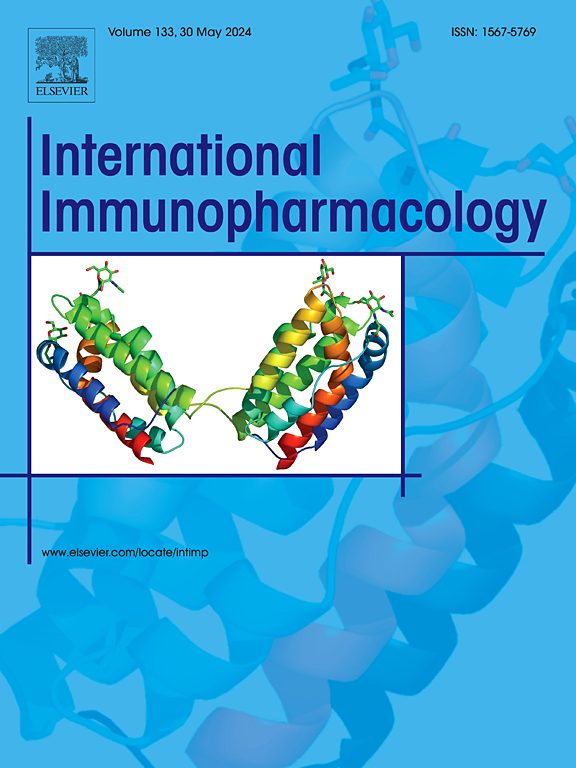Comparative analysis of BAG1 and BAG2: Insights into their structures, functions and implications in disease pathogenesis
IF 4.8
2区 医学
Q2 IMMUNOLOGY
引用次数: 0
Abstract
As BAG family members, Bcl-2 associated athanogene family protein 1 (BAG1) and 2 (BAG2) are implicated in multiple cellular processes, including apoptosis, autophagy, protein folding and homeostasis. Although structurally similar, they considerably differ in many ways. Unlike BAG2, BAG1 has four isoforms (BAG1L, BAG1M, BAG1S and BAG1 p29) displaying different expression features and functional patterns. BAG1 and BAG2 play different cellular functions by interacting with different molecules to participate in the regulation of various diseases, including cancer/tumor and neurodegenerative diseases. Commonly, BAG1 acts as a protective factor to predict a good prognosis of patients with some types of cancer or a risk factor in some other cancers, while BAG2 is regarded as a risk factor to promote cancer/tumor progression. In neurodegenerative diseases, BAG2 commonly acts as a neuroprotective factor. In this review, we summarized the differences in molacular structure and biological function between BAG1 and BAG2, as well as the influences of them on pathogenesis of diseases, and explore the prospects for their clinical therapy application by specifying the activators and inhibitors of BAG1 and BAG2, which might provide a better understanding of the underlying pathogenesis and developing the targeted therapy strategies for diseases.
BAG1 和 BAG2 的比较分析:洞察它们的结构、功能和在疾病发病机制中的意义
作为 BAG 家族的成员,Bcl-2 相关基因家族蛋白 1(BAG1)和 2(BAG2)与多种细胞过程有关,包括细胞凋亡、自噬、蛋白质折叠和平衡。虽然结构相似,但它们在许多方面存在很大差异。与 BAG2 不同,BAG1 有四种异构体(BAG1L、BAG1M、BAG1S 和 BAG1 p29),它们的表达特征和功能模式各不相同。BAG1 和 BAG2 与不同的分子相互作用,发挥不同的细胞功能,参与调控各种疾病,包括癌症/肿瘤和神经退行性疾病。通常,BAG1 是预测某些类型癌症患者良好预后的保护因子或某些其他癌症的危险因子,而 BAG2 则被视为促进癌症/肿瘤进展的危险因子。在神经退行性疾病中,BAG2 通常是一种神经保护因子。在这篇综述中,我们总结了BAG1和BAG2在分子结构和生物学功能上的差异,以及它们对疾病发病机制的影响,并通过明确BAG1和BAG2的激活剂和抑制剂,探讨了它们在临床治疗中的应用前景,这可能会让我们更好地理解疾病的潜在发病机制,并制定疾病的靶向治疗策略。
本文章由计算机程序翻译,如有差异,请以英文原文为准。
求助全文
约1分钟内获得全文
求助全文
来源期刊
CiteScore
8.40
自引率
3.60%
发文量
935
审稿时长
53 days
期刊介绍:
International Immunopharmacology is the primary vehicle for the publication of original research papers pertinent to the overlapping areas of immunology, pharmacology, cytokine biology, immunotherapy, immunopathology and immunotoxicology. Review articles that encompass these subjects are also welcome.
The subject material appropriate for submission includes:
• Clinical studies employing immunotherapy of any type including the use of: bacterial and chemical agents; thymic hormones, interferon, lymphokines, etc., in transplantation and diseases such as cancer, immunodeficiency, chronic infection and allergic, inflammatory or autoimmune disorders.
• Studies on the mechanisms of action of these agents for specific parameters of immune competence as well as the overall clinical state.
• Pre-clinical animal studies and in vitro studies on mechanisms of action with immunopotentiators, immunomodulators, immunoadjuvants and other pharmacological agents active on cells participating in immune or allergic responses.
• Pharmacological compounds, microbial products and toxicological agents that affect the lymphoid system, and their mechanisms of action.
• Agents that activate genes or modify transcription and translation within the immune response.
• Substances activated, generated, or released through immunologic or related pathways that are pharmacologically active.
• Production, function and regulation of cytokines and their receptors.
• Classical pharmacological studies on the effects of chemokines and bioactive factors released during immunological reactions.

 求助内容:
求助内容: 应助结果提醒方式:
应助结果提醒方式:


